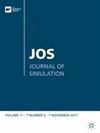Editorial: Special issue on modelling and simulation in the cloud computing era
IF 1.7
4区 工程技术
Q4 COMPUTER SCIENCE, INTERDISCIPLINARY APPLICATIONS
引用次数: 0
Abstract
Modelling and Simulation (M&S) represents one of the fundamental methods to design and study complex systems in many industrial and scientific domains such as transport, energy, and aerospace. M&S techniques enable the analysis and evaluation of many design alternatives while avoiding risks, costs, and failures that come with experimentations on the real system; this opportunity becomes crucial, when realworld tests are too costly to conduct in terms of safety, time, and other resources (Fujimoto et al., 2017). Cloud Computing has captured the interest of the scientific and industrial communities because of the benefits provided by its service models, i.e., Infrastructure as a Service (IaaS), Platform as a Service (PaaS), and Software as a Service (SaaS). These services allow developers to rapidly implement solutions that exploit computing and data storage capacity, network resources, and scalability, without having to deal with common issues related to the configuration of the Cloud infrastructure that is automatically managed by a specific service. Cloud Computing can be defined as a model for enabling ubiquitous, convenient, on-demand network access to a shared pool of configurable computing resources (e.g., servers, storage, and services) that can be rapidly provisioned and released with minimal effort in management (Mell & Grance, 2011). In this context, Cloud, Fog, and Edge computing allow organisations to exploit data processing and storage resources efficiently through the definition of a hierarchical data processing architecture. Fog and Edge computing are both extensions of the Cloud network, where at the lowest level there is the Edge, followed by the Fog level, and finally the Cloud level. The Edge layer allows reducing network traffic as data processing occurs locally on the devices. The Fog layer of the Cloud network architecture pushes intelligence down to the LAN layer, where data are processed in a gateway; thus, the Fog nodes are placed near devices with which it is communicating. Cloud, Fog, and Edge computing can offer suitable services to share and collaborate on M&S projects and perform complex simulation experiments faster and more efficiently through the Modelling and Simulation as a Service (MSaaS) model. While MSaaS provides an everincreasing number of opportunities, it also poses a significant number of pitfalls. One of the major pitfalls is that Cloud infrastructures are massive at all scales; as a consequence, the definition of MSaaS solutions is difficult without a deep knowledge of the involved infrastructures and technologies (Cayirci, 2013). The focus of this special issue is to provide current research results in M&S for Cloud Computing and vice versa. Specifically, the special issue aims at (i) presenting the current state-of-the-art about M&S solutions based on open standards, recent extensions, and innovations related to Cloud Computing technologies; (ii) identifying research directions and technologies that will drive innovations in M&S based on Cloud Computing Infrastructures, and (iii) adopts M&S techniques to formalise and study Cloud Computing environments and services. The application of Cloud-based M&S has increased since 2010 (Mansouri et al., 2020) however, studies, particularly on methodological and technological aspects in the convergence of Cloud Computing and M&S disciplines, continue to be few (Hannay et al., 2021; Tolk, 2020; Zhou et al., 2022). To fill this gap in the literature, we invited researchers and practitioners to submit contributions on conceptual, methodological, and technical advances in High-performance simulation in the Cloud, System Dependability, and Performance Analysis through Big data in the Cloud, Parallel and Distributed simulation through the Cloud services. The resulting contributions deal with a wide range of topics ranging from methodological aspects and development frameworks in adopting M&S in the Cloud Computing environment and vice versa, i.e., how Cloud Computing can support the definition of new M&S methods, models, and techniques. This special issue contains four papers, each of which is briefly described in the following. The paper titled “Mobile Experimentation using Modeling and Simulation in the Fog/Cloud” (by Khaldoon Al-Zoubi and Gabriel Wainer) proposes a method and some algorithms to define Fog nodes as private services in which different middleware run on different Virtual Machines to expose services (AlZoubi & Wainer, 2021). The focus of the research is on the mobility of clients that perform experiments through mobile devices. The proposed method and algorithms take into consideration the position of clients to identify available services that are nearby the Fog zone. To increase mobility assistance, the paper delineates the concept of “mobile simulation experiment”, in which experiments move with the device as it moves away from a specified Fog zone. JOURNAL OF SIMULATION 2022, VOL. 16, NO. 6, 547–549 https://doi.org/10.1080/17477778.2022.2080009社论:云计算时代的建模与仿真特刊
建模与仿真(M&S)代表了在许多工业和科学领域(如交通、能源和航空航天)设计和研究复杂系统的基本方法之一。M&S技术能够对多种设计方案进行分析和评估,同时避免在真实系统上进行实验所带来的风险、成本和失败;当现实世界的测试在安全性、时间和其他资源方面成本太高时,这个机会就变得至关重要了(Fujimoto等人,2017)。云计算已经引起了科学界和工业界的兴趣,因为它的服务模型提供了好处,即基础设施即服务(IaaS)、平台即服务(PaaS)和软件即服务(SaaS)。这些服务允许开发人员快速实现利用计算和数据存储容量、网络资源和可伸缩性的解决方案,而无需处理与由特定服务自动管理的云基础设施配置相关的常见问题。云计算可以被定义为一种模型,它使无处不在的、方便的、按需的网络访问一个可配置的计算资源(例如,服务器、存储和服务)的共享池成为可能,这些资源可以以最小的管理工作量快速配置和发布(Mell & Grance, 2011)。在这种情况下,云、雾和边缘计算允许组织通过定义分层数据处理架构有效地利用数据处理和存储资源。雾和边缘计算都是云网络的扩展,其中最低的级别是边缘,其次是雾级别,最后是云级别。边缘层允许减少网络流量,因为数据处理在设备上本地进行。云网络架构的雾层将智能下推到局域网层,在局域网层中,数据在网关中处理;因此,Fog节点被放置在与其通信的设备附近。云、雾和边缘计算可以提供合适的服务,通过建模和仿真即服务(MSaaS)模型,在M&S项目上共享和协作,并更快、更有效地执行复杂的仿真实验。虽然MSaaS提供了越来越多的机会,但它也带来了大量的陷阱。其中一个主要的陷阱是云基础设施在所有规模上都是巨大的;因此,如果没有对所涉及的基础设施和技术的深入了解,就很难定义MSaaS解决方案(Cayirci, 2013)。本期特刊的重点是提供云计算M&S的最新研究成果,反之亦然。具体来说,本期特刊旨在(i)介绍基于开放标准的M&S解决方案的最新技术,以及与云计算技术相关的最新扩展和创新;(ii)确定将推动基于云计算基础设施的M&S创新的研究方向和技术,以及(iii)采用M&S技术来形式化和研究云计算环境和服务。自2010年以来,基于云的M&S的应用有所增加(Mansouri等人,2020),然而,研究,特别是关于云计算和M&S学科融合的方法和技术方面的研究仍然很少(Hannay等人,2021;Tolk, 2020;周等人,2022)。为了填补这一文献空白,我们邀请研究人员和实践者就云中的高性能仿真、云中的大数据系统可靠性和性能分析、云服务中的并行和分布式仿真等方面的概念、方法和技术进展提交贡献。由此产生的贡献涉及范围广泛的主题,从方法方面和在云计算环境中采用M&S的开发框架,反之亦然,即云计算如何支持新的M&S方法、模型和技术的定义。本期特刊包含四篇论文,每一篇论文在下面作简要介绍。题为“在雾/云中使用建模和仿真的移动实验”的论文(由Khaldoon Al-Zoubi和Gabriel Wainer撰写)提出了一种方法和一些算法,将雾节点定义为私有服务,其中不同的中间件在不同的虚拟机上运行以暴露服务(AlZoubi和Wainer, 2021)。研究的重点是通过移动设备进行实验的客户的移动性。提出的方法和算法考虑了客户端的位置来识别雾区附近的可用服务。为了增加移动辅助,本文描述了“移动模拟实验”的概念,在实验中,当设备离开指定的雾区时,实验会随着设备移动。仿真学报,2022,vol . 16, no . 6 6, 547–549 https://doi.org/10.1080/17477778.2022.2080009
本文章由计算机程序翻译,如有差异,请以英文原文为准。
求助全文
约1分钟内获得全文
求助全文
来源期刊

Journal of Simulation
COMPUTER SCIENCE, INTERDISCIPLINARY APPLICATIONS-OPERATIONS RESEARCH & MANAGEMENT SCIENCE
CiteScore
5.70
自引率
16.00%
发文量
42
期刊介绍:
Journal of Simulation (JOS) aims to publish both articles and technical notes from researchers and practitioners active in the field of simulation. In JOS, the field of simulation includes the techniques, tools, methods and technologies of the application and the use of discrete-event simulation, agent-based modelling and system dynamics.
 求助内容:
求助内容: 应助结果提醒方式:
应助结果提醒方式:


